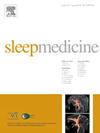Aperiodic and periodic components of resting-state EEG in primary insomnia
IF 3.8
2区 医学
Q1 CLINICAL NEUROLOGY
引用次数: 0
Abstract
Background
Insomnia is one of the most prevalent health concerns within the general population, with a multitude of existing electroencephalographic (EEG) spectral studies supporting heightened levels of high-frequency EEG activity as an index of cortical arousal. Nevertheless, traditional spectral analysis has been limited by its inability to distinguish between aperiodic and periodic elements. In contrast, a novel method, Spectral Parameterization (SpecParam), can separate these components and reveal the neural mechanisms of cortical arousal.
Methods
The aperiodic and periodic activities of 42 insomnia disorder (ID) patients and 45 age- and sex-matched healthy controls (HC) were evaluated during eyes-closed resting state. The associations between behavioral scales and aperiodic/periodic parameters were further examined to elucidate the underlying psychophysiological significance.
Results
We found that the aperiodic exponent was diminished in the ID group compared to the HC group. Additionally, the ID group exhibited an elevated central frequency and a more constrained bandwidth for periodic activity within the alpha band. Within-group correlation analyses revealed that a reduced exponent was associated with worse sleep quality and more frequent failures in inhibitory control within the ID group.
Conclusions
A smaller exponent within the ID group may reflect impaired inhibitory neuronal activity, potentially leading to cortical hyperarousal. The association of a smaller exponent with deteriorated sleep quality and impaired inhibitory control supports this hypothesis. Furthermore, the increased center frequency of the alpha band across extensive brain regions, along with a narrower alpha bandwidth in the left frontal and right parieto-occipital regions, may represent abnormal manifestations associated with excessive arousal. In summary, these results support the role of aperiodic activity as an index of impaired excitation/inhibition balance in neural activity within in ID group.

求助全文
约1分钟内获得全文
求助全文
来源期刊

Sleep medicine
医学-临床神经学
CiteScore
8.40
自引率
6.20%
发文量
1060
审稿时长
49 days
期刊介绍:
Sleep Medicine aims to be a journal no one involved in clinical sleep medicine can do without.
A journal primarily focussing on the human aspects of sleep, integrating the various disciplines that are involved in sleep medicine: neurology, clinical neurophysiology, internal medicine (particularly pulmonology and cardiology), psychology, psychiatry, sleep technology, pediatrics, neurosurgery, otorhinolaryngology, and dentistry.
The journal publishes the following types of articles: Reviews (also intended as a way to bridge the gap between basic sleep research and clinical relevance); Original Research Articles; Full-length articles; Brief communications; Controversies; Case reports; Letters to the Editor; Journal search and commentaries; Book reviews; Meeting announcements; Listing of relevant organisations plus web sites.
 求助内容:
求助内容: 应助结果提醒方式:
应助结果提醒方式:


